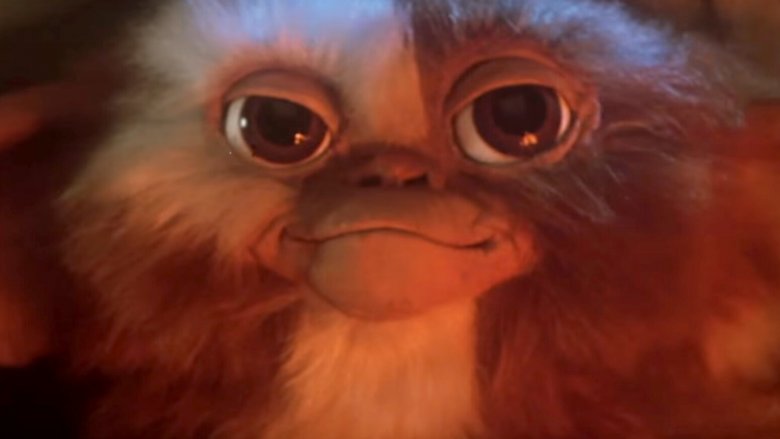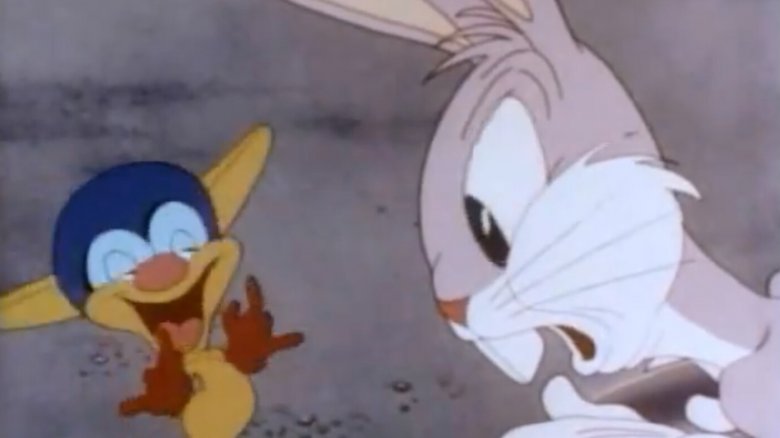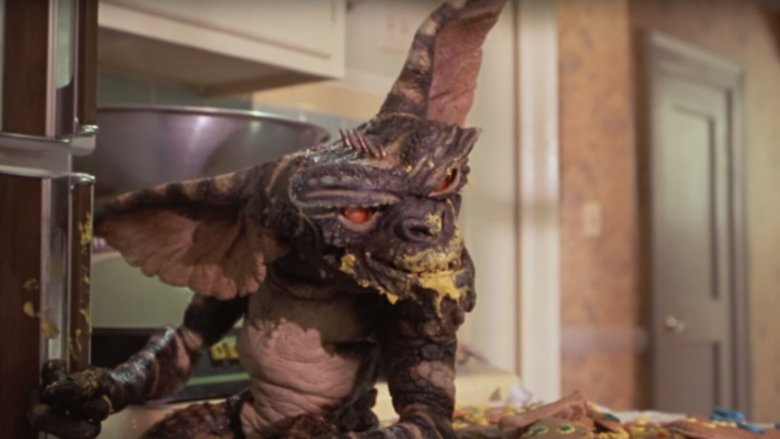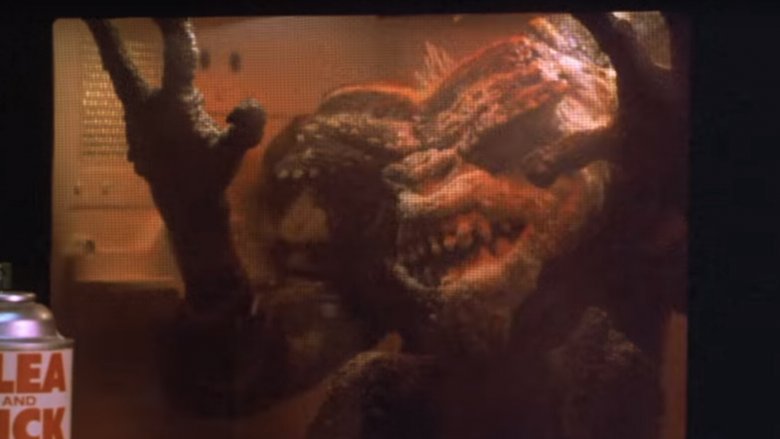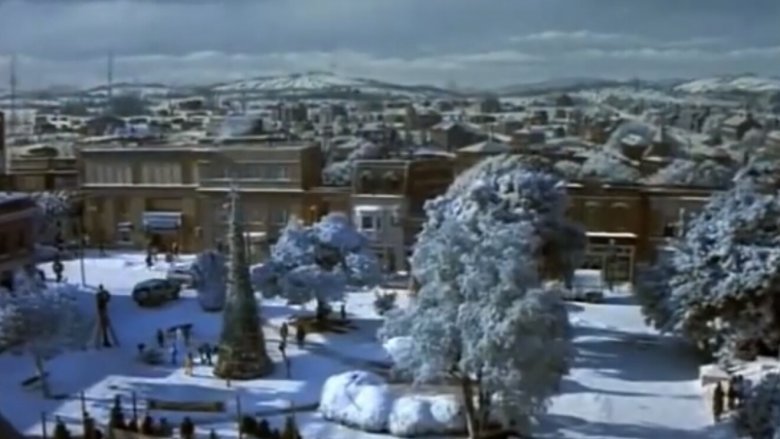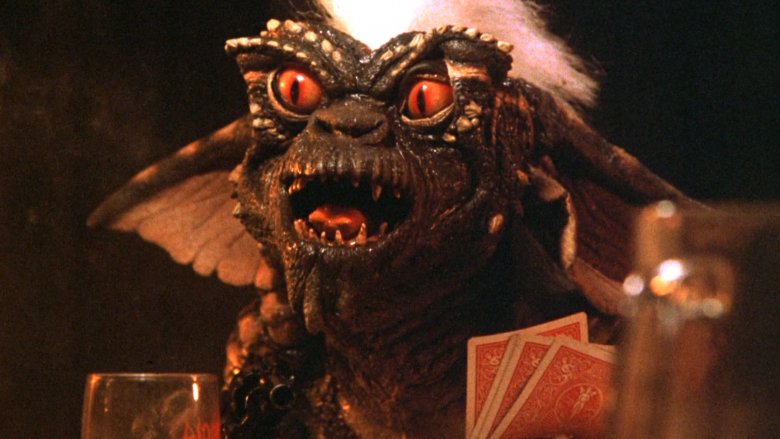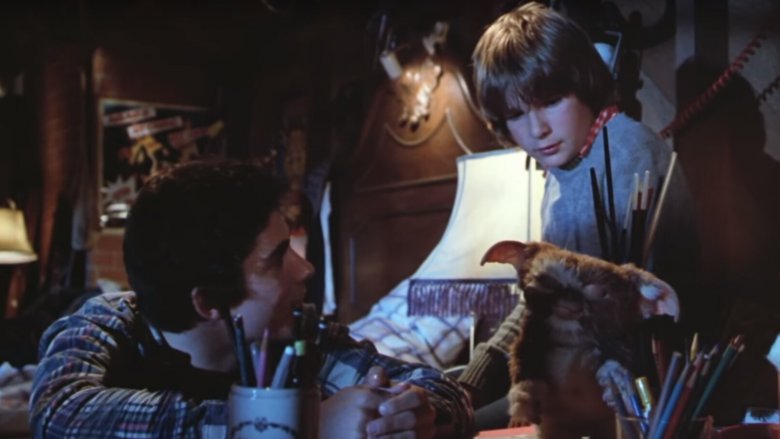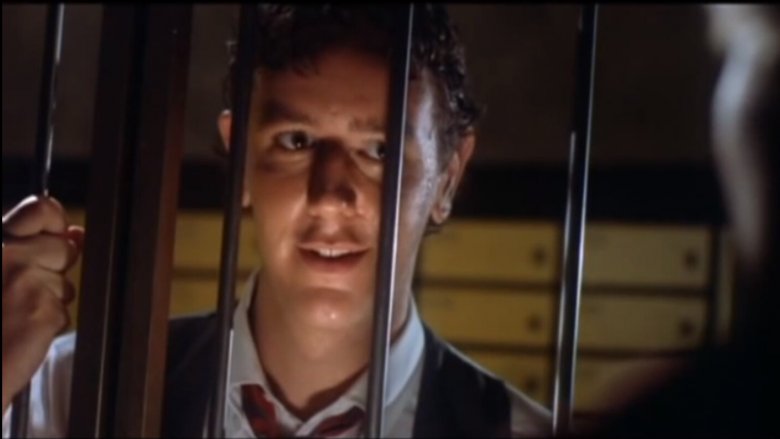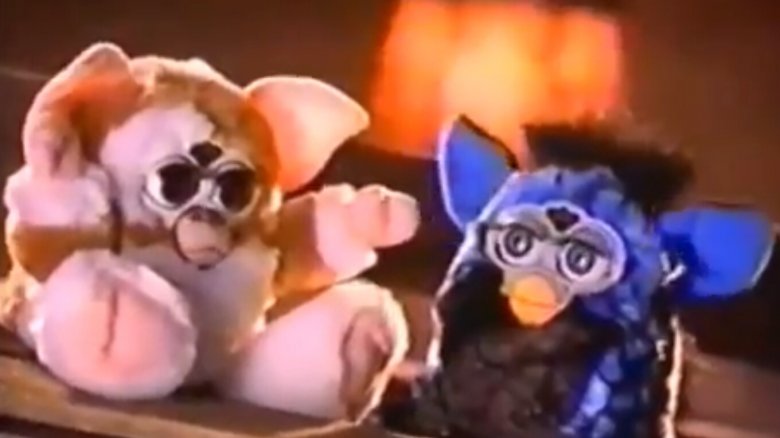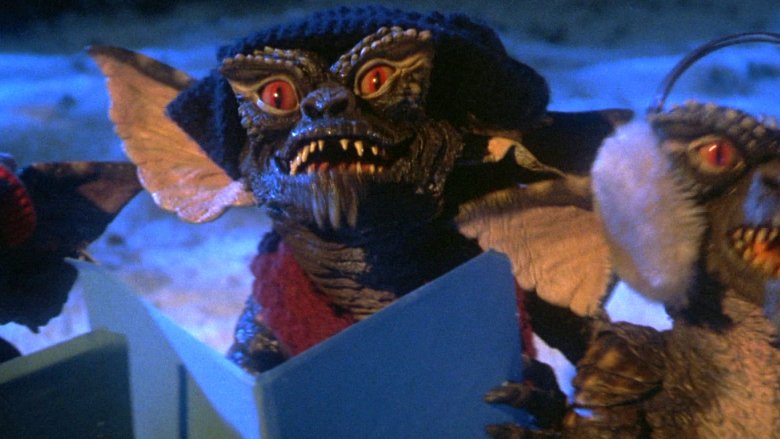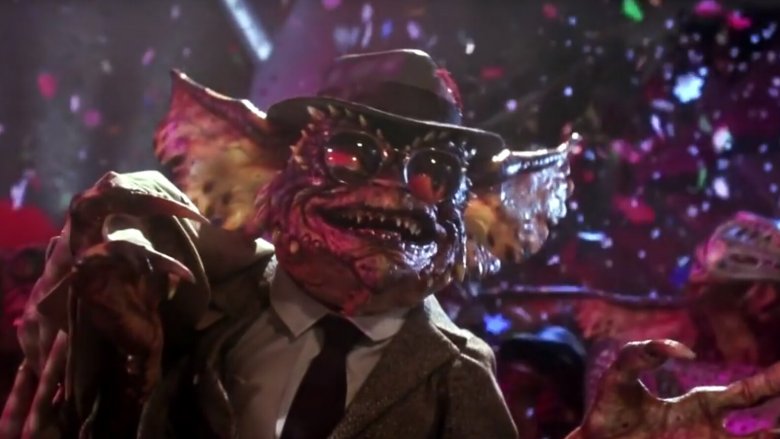The Untold Truth Of Gremlins
Gremlins will never die, even after more than three decades of bright light. New legions of fans keep multiplying like Mogwai in a swimming pool, devouring this cult classic like chicken wings after midnight. There are many reasons for its enduring appeal, from director Joe Dante's sense of chaotic fun to producer Steven Spielberg's keen eye for thrills. It certainly doesn't hurt that it's set at Christmastime, offering up some monster mayhem as an annual antidote to the season's sweetness.
While many of its charms are clear to the '80s and '90s kids who grew up with it, Gremlins had a long road to the big screen. Sometimes, the production faced setbacks and sabotage as if it was infected by little green monsters of its own. Whether you're a lifelong fan or a member of the new batch, join us for a romp through some lesser-known facts about the lore and legacy of Gremlins.
Gremlin history
The modern mythology of the gremlin was popularized during World War II. Destructive little imps with a taste for senseless destruction, gremlins were blamed by superstitious fighter pilots for all manner of electrical failure and technical difficulty. These legends eventually made their way into the 1984 film in the form of Mr. Futterman's (Dick Miller) drunken tales of his time in the Air Force.
But before the movie, the titular creatures popped up throughout pop culture for decades. Before he introduced the world to Wonka, witches, and giant peaches, Roald Dahl made gremlins the subject of his first children's book in 1943. Walt Disney attempted to adapt the book into an animated feature, though copyright complications eventually led to the abandonment of the project. Warner Bros., however, featured a Dahl-like gremlin in the Bugs Bunny cartoon "Falling Hare," and a 1963 episode of The Twilight Zone, "Nightmare at 20,000 Feet," found William Shatner face-to-face with a gremlin on the wing of an airplane.
A darker draft
The screenplay for Gremlins was one of the earliest projects by Chris Columbus, who would later become famous as the director of light comedies and family fantasies like Mrs. Doubtfire and the first two Harry Potter movies. The version of Gremlins that hit theaters in 1984 as a PG-rated spooky comedy fits with that legacy quite nicely. However, his initial vision for Gremlins was anything but warm and fuzzy.
Early Gremlins drafts by Columbus show a much darker and more vicious vision than the holiday classic we all know and love. In these scripts, several human (and canine) characters ended up devoured by the creatures. A key scene featured a grisly slaughter in a McDonald's. Perhaps most horrific was a scene in which Billy comes home just in time to see his mother's head bouncing down the stairs. All of these grim details would eventually be toned down once the script came into the hands of executive producer Steven Spielberg and director Joe Dante.
The spawning of PG-13
The final cut of Gremlins would bear little resemblance to the nasty horror of Columbus' early vision, eventually becoming known as a family Christmas classic. However, that doesn't mean the movie was without controversy when it was finally released. In fact, Gremlins would claim a special place in cinema history for being just a little too gross.
Before 1985, the Motion Picture Association of America had no rating between PG and R. Naturally, this meant that many PG-rated films before that time featured content that modern audiences would consider far beyond the realm of PG. The summer of 1984 featured two particular scenes that are frequently cited as prompting the need for something less restrictive than R but more severe than PG: the beating-heart sacrifice in Indiana Jones and the Temple of Doom and the exploding microwave gremlin in Gremlins. One could say that Steven Spielberg, as executive producer of Gremlins and director of Indiana Jones, was responsible for the ratings designation that defines a vast majority of modern blockbusters.
Familiar surroundings
The Universal Studios Tour was a major attraction long before an entire theme park sprung up around it, and has only grown more iconic over the course of a century. The studio's collection of sets and backlots allow guests to see firsthand the places where movie magic is made every day. One of its most famous stops is surely Courthouse Square, a location used in dozens of movie and television productions from the 1940s to the present.
It has been subjected to several fires and renovations, but Courthouse Square can be spotted by sharp-eyed audiences standing in for many movie small towns. It is perhaps most famous, though, as Hill Valley in the Back to the Future trilogy. Just one year before the original BTTF, Courthouse Square was Gremlins' Kingston Falls. The resemblance is particularly clear during the opening title sequence, in which Billy (Zach Galligan) dashes to work while greeting his neighbors. In fact, the bank where Billy works is just a layer of set dressing away from Back to the Future's pivotal diner.
Puppet show
As a horror-comedy set at Christmastime, Gremlins already had a lot to juggle before it even went in front of the cameras. Once the required sequences of creature mayhem entered the picture, the project exploded from low-budget creepshow to something of an effects extravaganza. Enter Chris Walas and his studio, a small band of puppet designers who brought life to the cute, cuddly Mogwai and the scaly, destructive gremlins they transformed into.
Walas and his crew were under constant pressures and limitations for the entirety of Gremlins' long production process. The movie's anarchic rampage meant long bouts of trial-and-error for the builders, with many puppets built for specific tasks, sometimes only to end up on the cutting room floor. The late decision that Gizmo would remain Billy's cute and cuddly companion rather than become a gremlin himself added mountains of unexpected work. "We were working on a very tight budget for what we were doing, so all of the puppets had to be designed and built to a purpose and for a price," Walas later recalled. "It was then more a matter of pushing those puppets a little beyond their limits."
Doodling in the margins
Director Joe Dante loves to, as he says, "doodle in the margins" of his own movies. Rapid-fire inside jokes and clever cameos became a trademark of his style (which is probably why he eventually directed a Looney Tunes movie), and Gremlins was one of his earliest opportunities to let loose. There are so many fun winks and split-second gags that Empire assembled a comprehensive Gremlins viewing guide to make sure fans catch every last nudge and nod.
There are references to the crew's previous projects, including some Spielberg shout-outs on the Kingston Falls theater marquee (where early working titles for both Close Encounters and E.T. are listed), a poster for Twilight Zone: The Movie (Spielberg and Dante's first collaboration), and a mention of Dr. Fantasy (the nickname of producer Frank Marshall). The scenes set at the trade show attended by Rand Petlzer (Hoyt Axton) feature brief appearances by Spielberg, composer Jerry Goldsmith, and Robby the Robot from Forbidden Planet. Legendary animation director Chuck Jones even pops up as Billy's artist friend in an early bar scene.
Vanishing villains
One of the most memorable scenes in Gremlins is the demise of the evil Mrs. Deagle (Polly Holliday), the heartless miser who is sent flying through the air after the creatures interfere with her electric stair lift. Mrs. Deagle originally loomed even larger over the entire story, as a cut subplot had her buying up swaths of land in a bid to construct a new power plant. This story thread was eventually dropped to maintain focus on the gremlins themselves.
Another major deletion involved the fates of two other antagonists: Billy's strict boss Mr. Corben (Edward Andrews) and sleazy coworker Gerald (Judge Reinhold). In the final cut, these two sources of stress in Billy's life simply vanish from the story once the gremlin rampage begins. However, scenes were shot which revealed an ironic death for Mr. Corben (bludgeoned by clocks after an earlier lecture about punctuality) and a comeuppance for Gerald that found him locked in the bank's vault.
Merchandising mania and a Furby flap
The character of Rand Peltzer dreams of creating a successful gift item, even suggesting that the multiplying Mogwai could become a trendy pet. It's a bit ironic, then that the box office success of Gremlins turned the movie into something of a merchandising juggernaut, with plush toys, masks, breakfast cereals, and all manner of knickknacks bearing the images of Gizmo and his mischievous offspring. This wave of toys rolls on, as new collectible figurines keep hitting shelves year after year.
One of the more interesting pieces of Gremlins memorabilia happened as the result of an alleged legal dispute. The Furby fad of the late '90s caught the attention of Joe Dante due to the virtual pet's eerie resemblance to Gizmo and company. Dante recalls pointing out the similarity to representatives at Warner Bros., and after some closed-door discussions, an officially licensed interactive Gizmo Furby hit the market soon after. "No doubt, some settlement money changed hands," Dante surmised.
Creature features
Speaking of ripoffs, no history of Gremlins would be complete without touching on the swarm of imitators that followed in its wake. In the years immediately after the film's release in 1984, several other flicks with one-word titles featuring diminutive rubber monster puppets chewed up screens. Even before the dawn of the '90s, there was Ghoulies, Critters, Troll, Munchies, and Hobgoblins.
They found varying levels of success, though none came anywhere near the level of the original. Most of them even spawned sequels. The Critters series, in fact, is notable for featuring early screen appearances by Billy Zane and Leonardo DiCaprio. Troll 2, though not even intended to be a sequel to Troll, would go on to find fame as the "best worst movie." Joe Dante, whose career started with the Roger Corman-produced Jaws ripoff Piranha, remains good-natured about the imitators, even commenting on each one for Yahoo! Entertainment. Munchies received Dante's particular blessing, as it was directed by Gremlins editor Tina Hirsch.
Skewered by its own sequel
Even as other studios churned out low-budget imitations, Warner Bros. struggled to put together an official sequel to Gremlins. Dante shied away from the project for a long time, feeling burned out after the arduous production. After six years of failures and stalled attempts, Warner came back to Dante with an all-too-tempting offer: full creative control and a huge budget. He accepted, and delivered one of the strangest sequels in blockbuster history, largely designed to show, as Dante put it, why "there didn't need to be a sequel to Gremlins."
Gremlins 2: The New Batch finds the beasts taking over a high-tech "smart building" in New York City, opening the floodgates for all kinds of social satire and over-the-top frame-breaking gags, building to a big, climactic musical number. Audiences didn't really know what to make of it upon its release in 1990, greeting it with disappointing box office returns and middling reviews. However, in recent years, it's been reevaluated as a cult classic. One of the qualities fans love most about it is its tongue-in-cheek parodies of the first Gremlins, particularly a breakdown of the famous — but nonsensical — Mogwai rules.
